Political and Ethical Issues in Australian Aged Care System
VerifiedAdded on 2022/09/26
|7
|1899
|21
Essay
AI Summary
This essay provides a comprehensive overview of the Australian aged care system, addressing the care provided to individuals aged 65 and above (and 50+ for Indigenous Australians) requiring support to perform daily activities. It explores methods to ensure the independence of older people within society, highlighting the role of various care providers and government subsidies. The essay delves into the people-centered model of health service delivery, its principles, and its critique, discussing both positive and negative aspects. Furthermore, it examines the political and ethical issues associated with a user contribution system in aged care, including funding, care quality, and the impact of market forces. The essay concludes by emphasizing the importance of prioritizing aged care within Australia's social and economic framework and the need for reforms to improve the quality of care for older people.
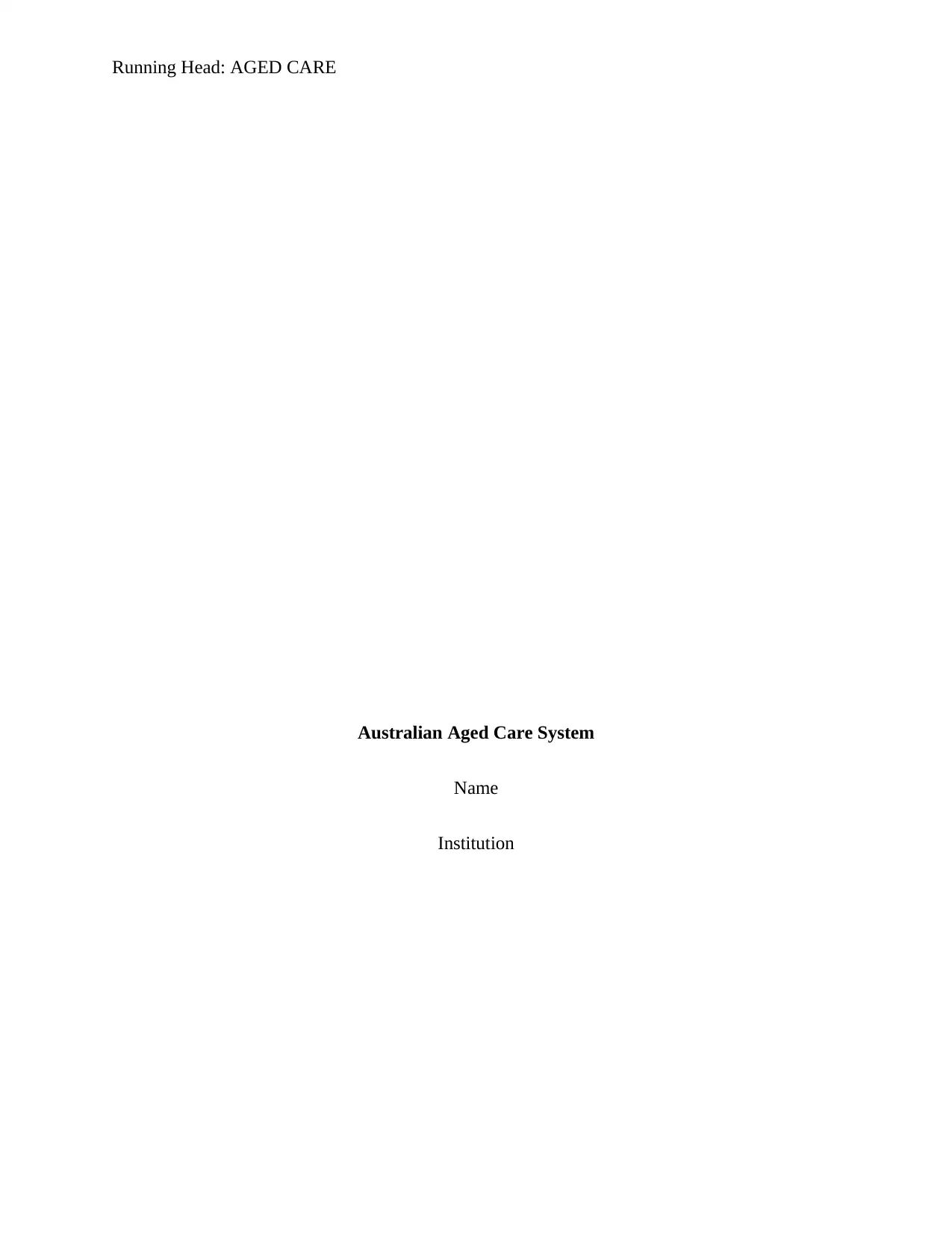
Running Head: AGED CARE
Australian Aged Care System
Name
Institution
Australian Aged Care System
Name
Institution
Paraphrase This Document
Need a fresh take? Get an instant paraphrase of this document with our AI Paraphraser
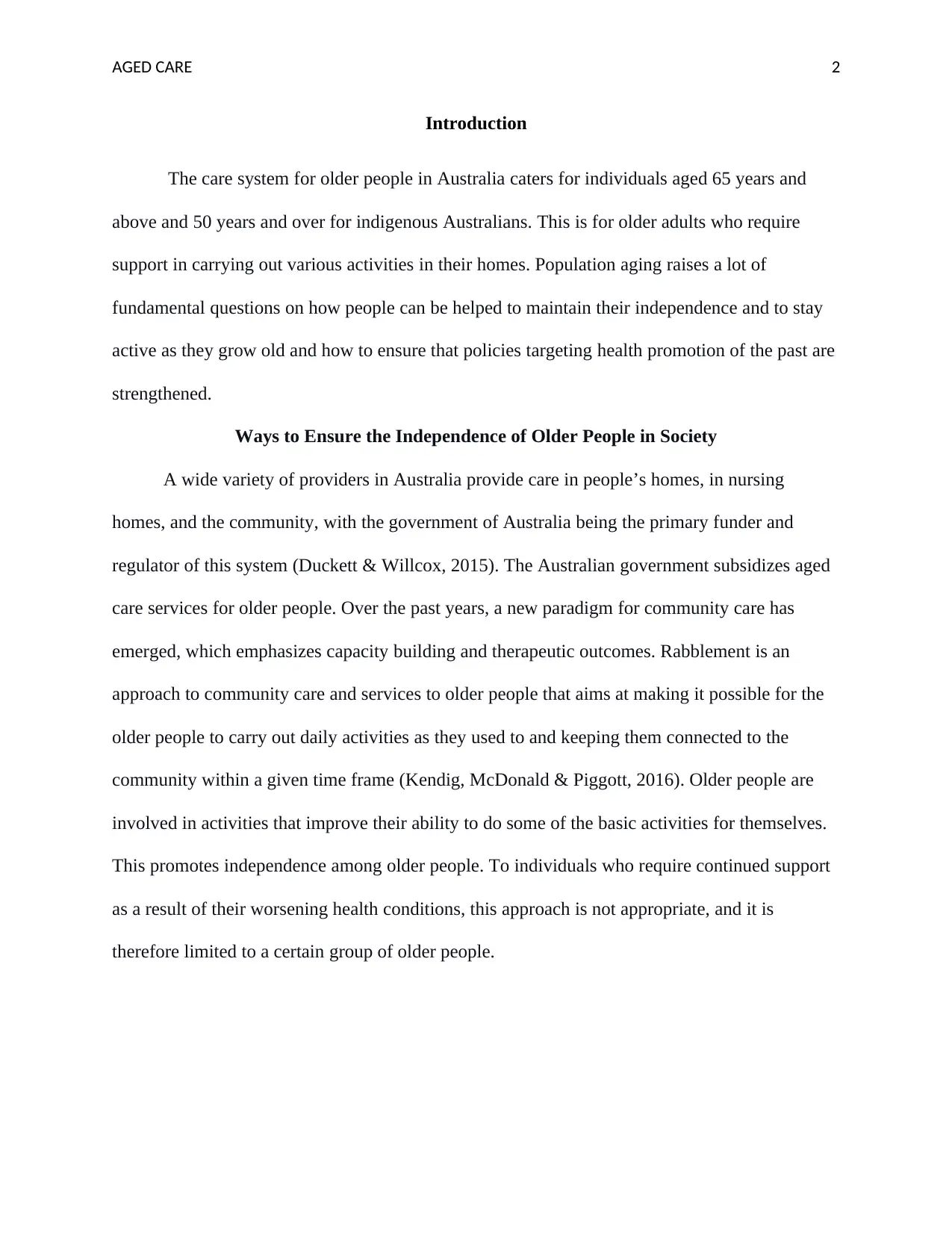
AGED CARE 2
Introduction
The care system for older people in Australia caters for individuals aged 65 years and
above and 50 years and over for indigenous Australians. This is for older adults who require
support in carrying out various activities in their homes. Population aging raises a lot of
fundamental questions on how people can be helped to maintain their independence and to stay
active as they grow old and how to ensure that policies targeting health promotion of the past are
strengthened.
Ways to Ensure the Independence of Older People in Society
A wide variety of providers in Australia provide care in people’s homes, in nursing
homes, and the community, with the government of Australia being the primary funder and
regulator of this system (Duckett & Willcox, 2015). The Australian government subsidizes aged
care services for older people. Over the past years, a new paradigm for community care has
emerged, which emphasizes capacity building and therapeutic outcomes. Rabblement is an
approach to community care and services to older people that aims at making it possible for the
older people to carry out daily activities as they used to and keeping them connected to the
community within a given time frame (Kendig, McDonald & Piggott, 2016). Older people are
involved in activities that improve their ability to do some of the basic activities for themselves.
This promotes independence among older people. To individuals who require continued support
as a result of their worsening health conditions, this approach is not appropriate, and it is
therefore limited to a certain group of older people.
Introduction
The care system for older people in Australia caters for individuals aged 65 years and
above and 50 years and over for indigenous Australians. This is for older adults who require
support in carrying out various activities in their homes. Population aging raises a lot of
fundamental questions on how people can be helped to maintain their independence and to stay
active as they grow old and how to ensure that policies targeting health promotion of the past are
strengthened.
Ways to Ensure the Independence of Older People in Society
A wide variety of providers in Australia provide care in people’s homes, in nursing
homes, and the community, with the government of Australia being the primary funder and
regulator of this system (Duckett & Willcox, 2015). The Australian government subsidizes aged
care services for older people. Over the past years, a new paradigm for community care has
emerged, which emphasizes capacity building and therapeutic outcomes. Rabblement is an
approach to community care and services to older people that aims at making it possible for the
older people to carry out daily activities as they used to and keeping them connected to the
community within a given time frame (Kendig, McDonald & Piggott, 2016). Older people are
involved in activities that improve their ability to do some of the basic activities for themselves.
This promotes independence among older people. To individuals who require continued support
as a result of their worsening health conditions, this approach is not appropriate, and it is
therefore limited to a certain group of older people.
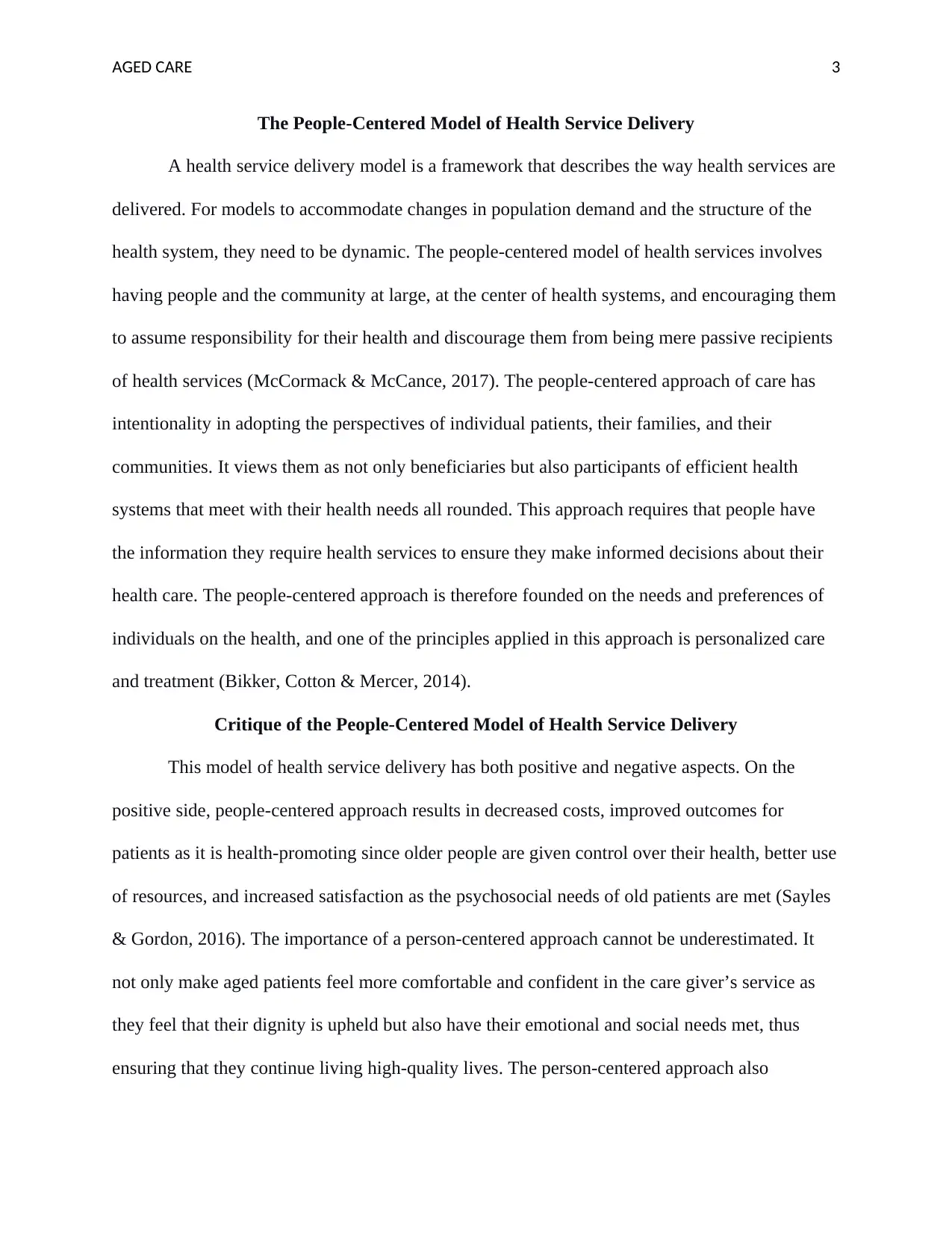
AGED CARE 3
The People-Centered Model of Health Service Delivery
A health service delivery model is a framework that describes the way health services are
delivered. For models to accommodate changes in population demand and the structure of the
health system, they need to be dynamic. The people-centered model of health services involves
having people and the community at large, at the center of health systems, and encouraging them
to assume responsibility for their health and discourage them from being mere passive recipients
of health services (McCormack & McCance, 2017). The people-centered approach of care has
intentionality in adopting the perspectives of individual patients, their families, and their
communities. It views them as not only beneficiaries but also participants of efficient health
systems that meet with their health needs all rounded. This approach requires that people have
the information they require health services to ensure they make informed decisions about their
health care. The people-centered approach is therefore founded on the needs and preferences of
individuals on the health, and one of the principles applied in this approach is personalized care
and treatment (Bikker, Cotton & Mercer, 2014).
Critique of the People-Centered Model of Health Service Delivery
This model of health service delivery has both positive and negative aspects. On the
positive side, people-centered approach results in decreased costs, improved outcomes for
patients as it is health-promoting since older people are given control over their health, better use
of resources, and increased satisfaction as the psychosocial needs of old patients are met (Sayles
& Gordon, 2016). The importance of a person-centered approach cannot be underestimated. It
not only make aged patients feel more comfortable and confident in the care giver’s service as
they feel that their dignity is upheld but also have their emotional and social needs met, thus
ensuring that they continue living high-quality lives. The person-centered approach also
The People-Centered Model of Health Service Delivery
A health service delivery model is a framework that describes the way health services are
delivered. For models to accommodate changes in population demand and the structure of the
health system, they need to be dynamic. The people-centered model of health services involves
having people and the community at large, at the center of health systems, and encouraging them
to assume responsibility for their health and discourage them from being mere passive recipients
of health services (McCormack & McCance, 2017). The people-centered approach of care has
intentionality in adopting the perspectives of individual patients, their families, and their
communities. It views them as not only beneficiaries but also participants of efficient health
systems that meet with their health needs all rounded. This approach requires that people have
the information they require health services to ensure they make informed decisions about their
health care. The people-centered approach is therefore founded on the needs and preferences of
individuals on the health, and one of the principles applied in this approach is personalized care
and treatment (Bikker, Cotton & Mercer, 2014).
Critique of the People-Centered Model of Health Service Delivery
This model of health service delivery has both positive and negative aspects. On the
positive side, people-centered approach results in decreased costs, improved outcomes for
patients as it is health-promoting since older people are given control over their health, better use
of resources, and increased satisfaction as the psychosocial needs of old patients are met (Sayles
& Gordon, 2016). The importance of a person-centered approach cannot be underestimated. It
not only make aged patients feel more comfortable and confident in the care giver’s service as
they feel that their dignity is upheld but also have their emotional and social needs met, thus
ensuring that they continue living high-quality lives. The person-centered approach also
⊘ This is a preview!⊘
Do you want full access?
Subscribe today to unlock all pages.

Trusted by 1+ million students worldwide
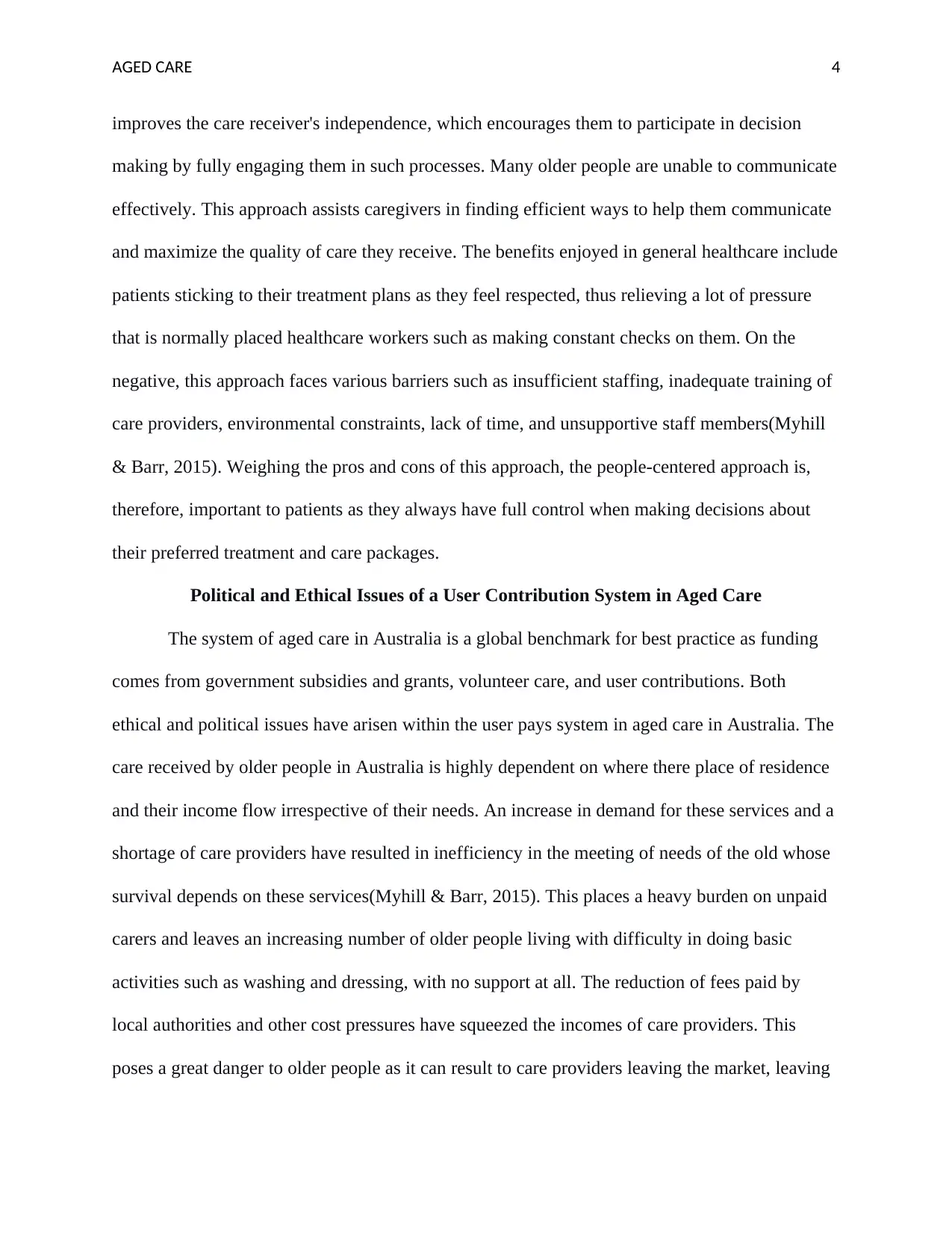
AGED CARE 4
improves the care receiver's independence, which encourages them to participate in decision
making by fully engaging them in such processes. Many older people are unable to communicate
effectively. This approach assists caregivers in finding efficient ways to help them communicate
and maximize the quality of care they receive. The benefits enjoyed in general healthcare include
patients sticking to their treatment plans as they feel respected, thus relieving a lot of pressure
that is normally placed healthcare workers such as making constant checks on them. On the
negative, this approach faces various barriers such as insufficient staffing, inadequate training of
care providers, environmental constraints, lack of time, and unsupportive staff members(Myhill
& Barr, 2015). Weighing the pros and cons of this approach, the people-centered approach is,
therefore, important to patients as they always have full control when making decisions about
their preferred treatment and care packages.
Political and Ethical Issues of a User Contribution System in Aged Care
The system of aged care in Australia is a global benchmark for best practice as funding
comes from government subsidies and grants, volunteer care, and user contributions. Both
ethical and political issues have arisen within the user pays system in aged care in Australia. The
care received by older people in Australia is highly dependent on where there place of residence
and their income flow irrespective of their needs. An increase in demand for these services and a
shortage of care providers have resulted in inefficiency in the meeting of needs of the old whose
survival depends on these services(Myhill & Barr, 2015). This places a heavy burden on unpaid
carers and leaves an increasing number of older people living with difficulty in doing basic
activities such as washing and dressing, with no support at all. The reduction of fees paid by
local authorities and other cost pressures have squeezed the incomes of care providers. This
poses a great danger to older people as it can result to care providers leaving the market, leaving
improves the care receiver's independence, which encourages them to participate in decision
making by fully engaging them in such processes. Many older people are unable to communicate
effectively. This approach assists caregivers in finding efficient ways to help them communicate
and maximize the quality of care they receive. The benefits enjoyed in general healthcare include
patients sticking to their treatment plans as they feel respected, thus relieving a lot of pressure
that is normally placed healthcare workers such as making constant checks on them. On the
negative, this approach faces various barriers such as insufficient staffing, inadequate training of
care providers, environmental constraints, lack of time, and unsupportive staff members(Myhill
& Barr, 2015). Weighing the pros and cons of this approach, the people-centered approach is,
therefore, important to patients as they always have full control when making decisions about
their preferred treatment and care packages.
Political and Ethical Issues of a User Contribution System in Aged Care
The system of aged care in Australia is a global benchmark for best practice as funding
comes from government subsidies and grants, volunteer care, and user contributions. Both
ethical and political issues have arisen within the user pays system in aged care in Australia. The
care received by older people in Australia is highly dependent on where there place of residence
and their income flow irrespective of their needs. An increase in demand for these services and a
shortage of care providers have resulted in inefficiency in the meeting of needs of the old whose
survival depends on these services(Myhill & Barr, 2015). This places a heavy burden on unpaid
carers and leaves an increasing number of older people living with difficulty in doing basic
activities such as washing and dressing, with no support at all. The reduction of fees paid by
local authorities and other cost pressures have squeezed the incomes of care providers. This
poses a great danger to older people as it can result to care providers leaving the market, leaving
Paraphrase This Document
Need a fresh take? Get an instant paraphrase of this document with our AI Paraphraser
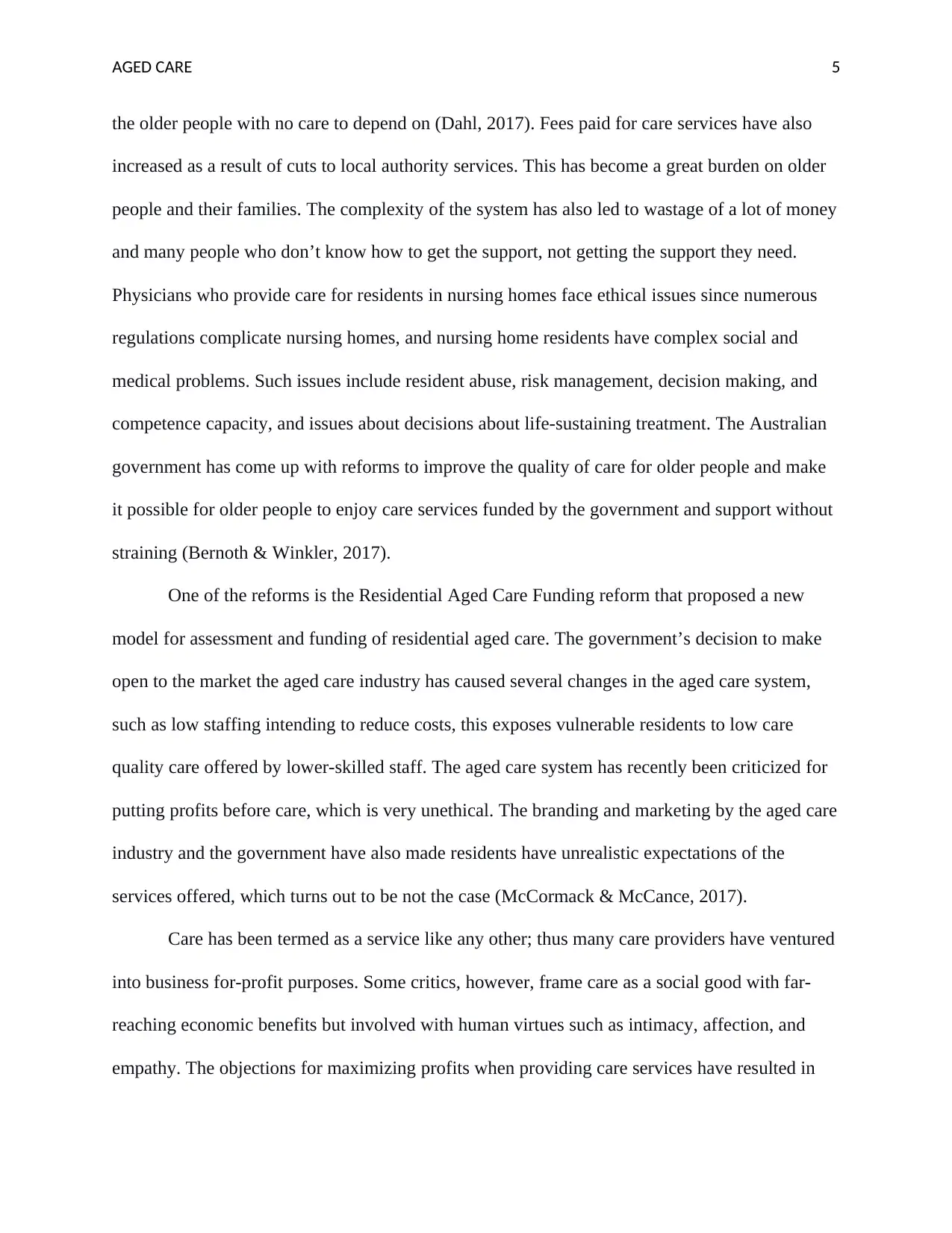
AGED CARE 5
the older people with no care to depend on (Dahl, 2017). Fees paid for care services have also
increased as a result of cuts to local authority services. This has become a great burden on older
people and their families. The complexity of the system has also led to wastage of a lot of money
and many people who don’t know how to get the support, not getting the support they need.
Physicians who provide care for residents in nursing homes face ethical issues since numerous
regulations complicate nursing homes, and nursing home residents have complex social and
medical problems. Such issues include resident abuse, risk management, decision making, and
competence capacity, and issues about decisions about life-sustaining treatment. The Australian
government has come up with reforms to improve the quality of care for older people and make
it possible for older people to enjoy care services funded by the government and support without
straining (Bernoth & Winkler, 2017).
One of the reforms is the Residential Aged Care Funding reform that proposed a new
model for assessment and funding of residential aged care. The government’s decision to make
open to the market the aged care industry has caused several changes in the aged care system,
such as low staffing intending to reduce costs, this exposes vulnerable residents to low care
quality care offered by lower-skilled staff. The aged care system has recently been criticized for
putting profits before care, which is very unethical. The branding and marketing by the aged care
industry and the government have also made residents have unrealistic expectations of the
services offered, which turns out to be not the case (McCormack & McCance, 2017).
Care has been termed as a service like any other; thus many care providers have ventured
into business for-profit purposes. Some critics, however, frame care as a social good with far-
reaching economic benefits but involved with human virtues such as intimacy, affection, and
empathy. The objections for maximizing profits when providing care services have resulted in
the older people with no care to depend on (Dahl, 2017). Fees paid for care services have also
increased as a result of cuts to local authority services. This has become a great burden on older
people and their families. The complexity of the system has also led to wastage of a lot of money
and many people who don’t know how to get the support, not getting the support they need.
Physicians who provide care for residents in nursing homes face ethical issues since numerous
regulations complicate nursing homes, and nursing home residents have complex social and
medical problems. Such issues include resident abuse, risk management, decision making, and
competence capacity, and issues about decisions about life-sustaining treatment. The Australian
government has come up with reforms to improve the quality of care for older people and make
it possible for older people to enjoy care services funded by the government and support without
straining (Bernoth & Winkler, 2017).
One of the reforms is the Residential Aged Care Funding reform that proposed a new
model for assessment and funding of residential aged care. The government’s decision to make
open to the market the aged care industry has caused several changes in the aged care system,
such as low staffing intending to reduce costs, this exposes vulnerable residents to low care
quality care offered by lower-skilled staff. The aged care system has recently been criticized for
putting profits before care, which is very unethical. The branding and marketing by the aged care
industry and the government have also made residents have unrealistic expectations of the
services offered, which turns out to be not the case (McCormack & McCance, 2017).
Care has been termed as a service like any other; thus many care providers have ventured
into business for-profit purposes. Some critics, however, frame care as a social good with far-
reaching economic benefits but involved with human virtues such as intimacy, affection, and
empathy. The objections for maximizing profits when providing care services have resulted in
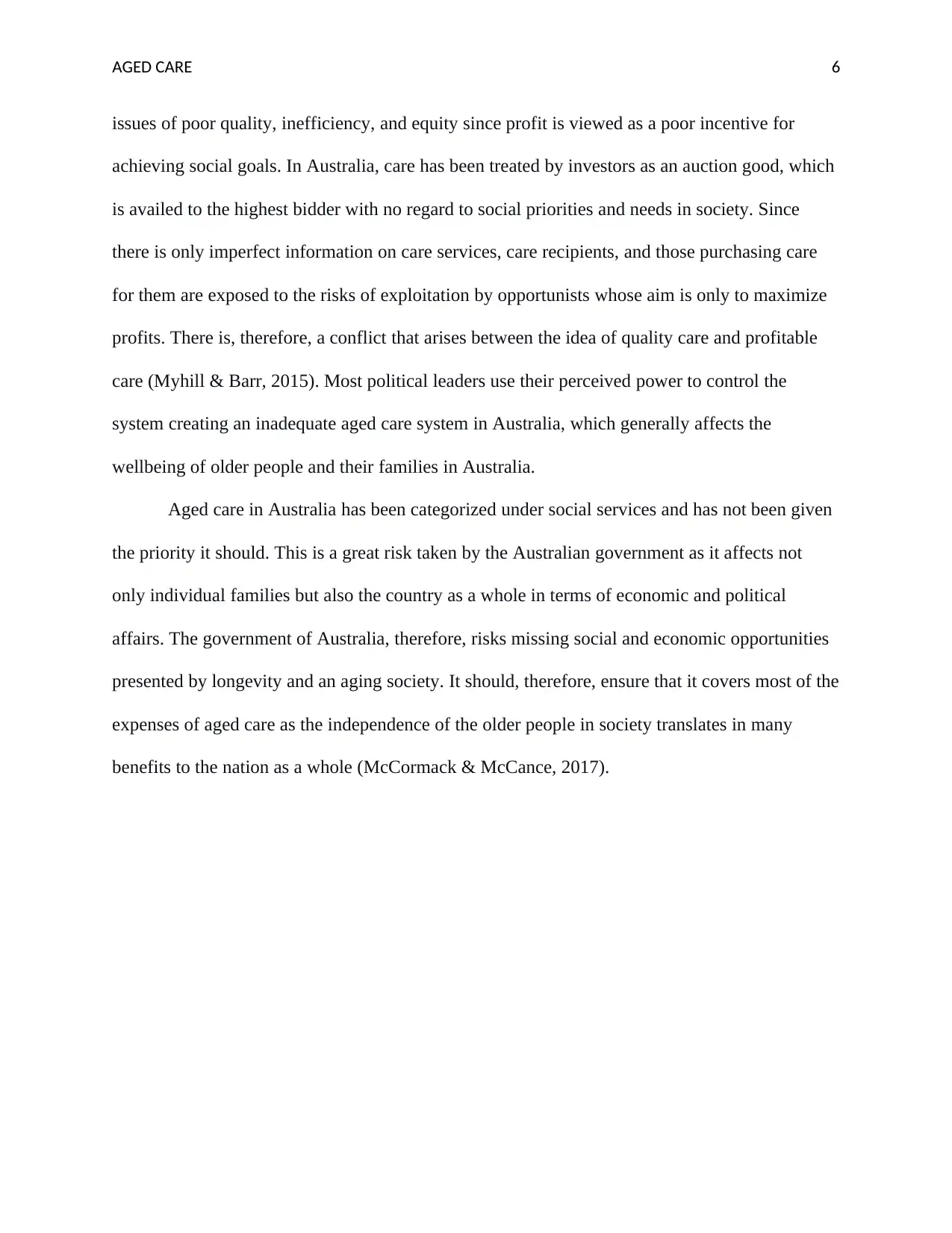
AGED CARE 6
issues of poor quality, inefficiency, and equity since profit is viewed as a poor incentive for
achieving social goals. In Australia, care has been treated by investors as an auction good, which
is availed to the highest bidder with no regard to social priorities and needs in society. Since
there is only imperfect information on care services, care recipients, and those purchasing care
for them are exposed to the risks of exploitation by opportunists whose aim is only to maximize
profits. There is, therefore, a conflict that arises between the idea of quality care and profitable
care (Myhill & Barr, 2015). Most political leaders use their perceived power to control the
system creating an inadequate aged care system in Australia, which generally affects the
wellbeing of older people and their families in Australia.
Aged care in Australia has been categorized under social services and has not been given
the priority it should. This is a great risk taken by the Australian government as it affects not
only individual families but also the country as a whole in terms of economic and political
affairs. The government of Australia, therefore, risks missing social and economic opportunities
presented by longevity and an aging society. It should, therefore, ensure that it covers most of the
expenses of aged care as the independence of the older people in society translates in many
benefits to the nation as a whole (McCormack & McCance, 2017).
issues of poor quality, inefficiency, and equity since profit is viewed as a poor incentive for
achieving social goals. In Australia, care has been treated by investors as an auction good, which
is availed to the highest bidder with no regard to social priorities and needs in society. Since
there is only imperfect information on care services, care recipients, and those purchasing care
for them are exposed to the risks of exploitation by opportunists whose aim is only to maximize
profits. There is, therefore, a conflict that arises between the idea of quality care and profitable
care (Myhill & Barr, 2015). Most political leaders use their perceived power to control the
system creating an inadequate aged care system in Australia, which generally affects the
wellbeing of older people and their families in Australia.
Aged care in Australia has been categorized under social services and has not been given
the priority it should. This is a great risk taken by the Australian government as it affects not
only individual families but also the country as a whole in terms of economic and political
affairs. The government of Australia, therefore, risks missing social and economic opportunities
presented by longevity and an aging society. It should, therefore, ensure that it covers most of the
expenses of aged care as the independence of the older people in society translates in many
benefits to the nation as a whole (McCormack & McCance, 2017).
⊘ This is a preview!⊘
Do you want full access?
Subscribe today to unlock all pages.

Trusted by 1+ million students worldwide
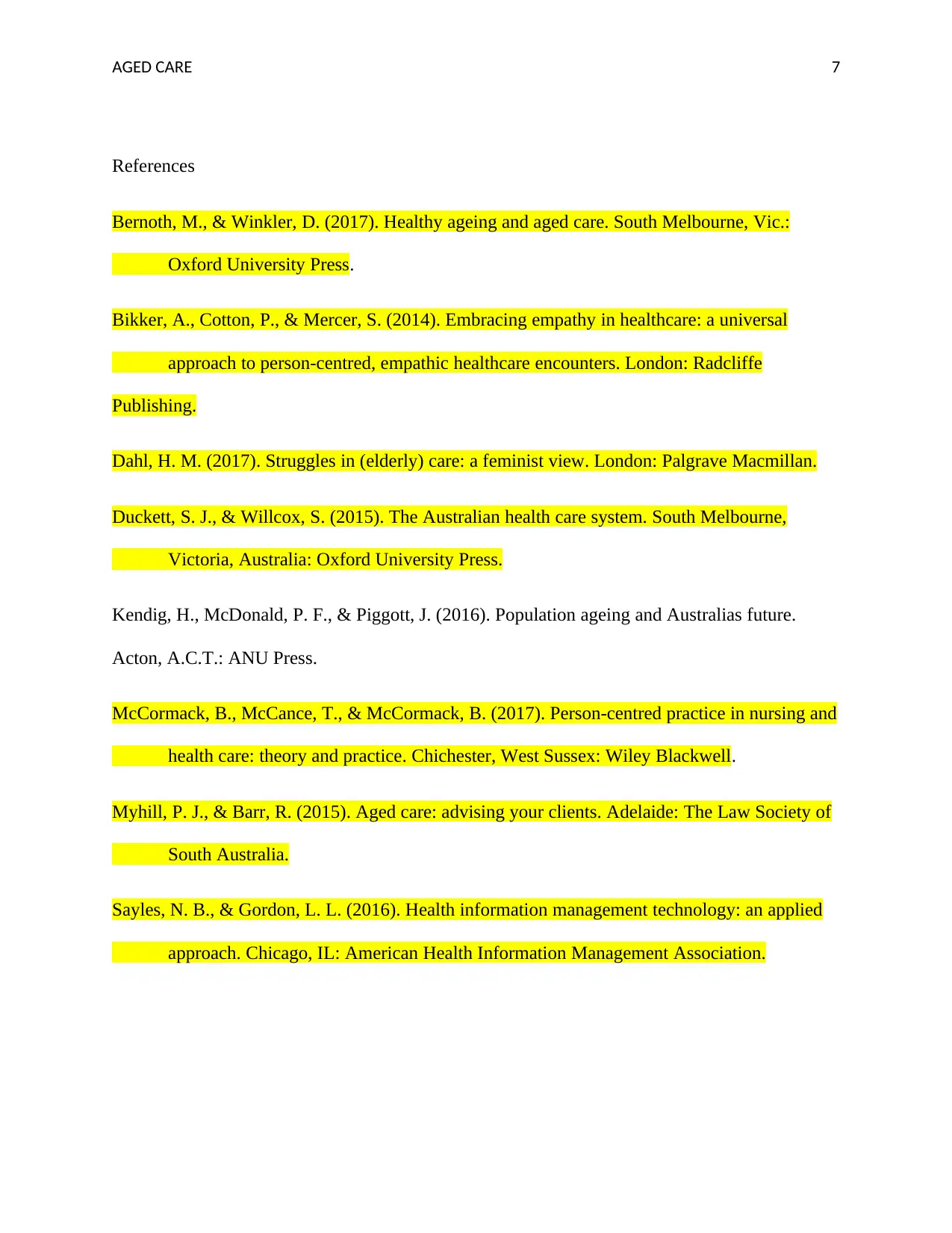
AGED CARE 7
References
Bernoth, M., & Winkler, D. (2017). Healthy ageing and aged care. South Melbourne, Vic.:
Oxford University Press.
Bikker, A., Cotton, P., & Mercer, S. (2014). Embracing empathy in healthcare: a universal
approach to person-centred, empathic healthcare encounters. London: Radcliffe
Publishing.
Dahl, H. M. (2017). Struggles in (elderly) care: a feminist view. London: Palgrave Macmillan.
Duckett, S. J., & Willcox, S. (2015). The Australian health care system. South Melbourne,
Victoria, Australia: Oxford University Press.
Kendig, H., McDonald, P. F., & Piggott, J. (2016). Population ageing and Australias future.
Acton, A.C.T.: ANU Press.
McCormack, B., McCance, T., & McCormack, B. (2017). Person-centred practice in nursing and
health care: theory and practice. Chichester, West Sussex: Wiley Blackwell.
Myhill, P. J., & Barr, R. (2015). Aged care: advising your clients. Adelaide: The Law Society of
South Australia.
Sayles, N. B., & Gordon, L. L. (2016). Health information management technology: an applied
approach. Chicago, IL: American Health Information Management Association.
References
Bernoth, M., & Winkler, D. (2017). Healthy ageing and aged care. South Melbourne, Vic.:
Oxford University Press.
Bikker, A., Cotton, P., & Mercer, S. (2014). Embracing empathy in healthcare: a universal
approach to person-centred, empathic healthcare encounters. London: Radcliffe
Publishing.
Dahl, H. M. (2017). Struggles in (elderly) care: a feminist view. London: Palgrave Macmillan.
Duckett, S. J., & Willcox, S. (2015). The Australian health care system. South Melbourne,
Victoria, Australia: Oxford University Press.
Kendig, H., McDonald, P. F., & Piggott, J. (2016). Population ageing and Australias future.
Acton, A.C.T.: ANU Press.
McCormack, B., McCance, T., & McCormack, B. (2017). Person-centred practice in nursing and
health care: theory and practice. Chichester, West Sussex: Wiley Blackwell.
Myhill, P. J., & Barr, R. (2015). Aged care: advising your clients. Adelaide: The Law Society of
South Australia.
Sayles, N. B., & Gordon, L. L. (2016). Health information management technology: an applied
approach. Chicago, IL: American Health Information Management Association.
1 out of 7
Related Documents
Your All-in-One AI-Powered Toolkit for Academic Success.
+13062052269
info@desklib.com
Available 24*7 on WhatsApp / Email
![[object Object]](/_next/static/media/star-bottom.7253800d.svg)
Unlock your academic potential
Copyright © 2020–2025 A2Z Services. All Rights Reserved. Developed and managed by ZUCOL.





